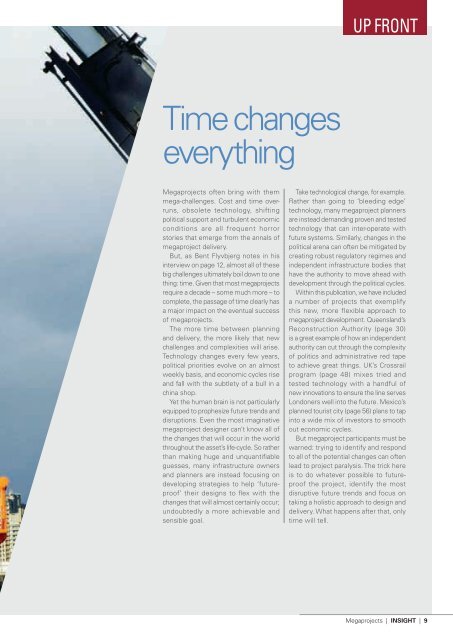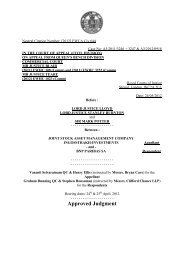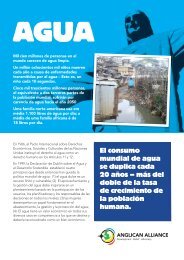Megaprojects - KPMG
Megaprojects - KPMG
Megaprojects - KPMG
Create successful ePaper yourself
Turn your PDF publications into a flip-book with our unique Google optimized e-Paper software.
UP FRONT<br />
Time changes<br />
everything<br />
<strong>Megaprojects</strong> often bring with them<br />
mega-challenges. Cost and time overruns,<br />
obsolete technology, shifting<br />
political support and turbulent economic<br />
conditions are all frequent horror<br />
stories that emerge from the annals of<br />
megaproject delivery.<br />
But, as Bent Flyvbjerg notes in his<br />
interview on page 12, almost all of these<br />
big challenges ultimately boil down to one<br />
thing: time. Given that most megaprojects<br />
require a decade – some much more – to<br />
complete, the passage of time clearly has<br />
a major impact on the eventual success<br />
of megaprojects.<br />
The more time between planning<br />
and delivery, the more likely that new<br />
challenges and complexities will arise.<br />
Technology changes every few years,<br />
political priorities evolve on an almost<br />
weekly basis, and economic cycles rise<br />
and fall with the subtlety of a bull in a<br />
china shop.<br />
Yet the human brain is not particularly<br />
equipped to prophesize future trends and<br />
disruptions. Even the most imaginative<br />
megaproject designer can’t know all of<br />
the changes that will occur in the world<br />
throughout the asset’s life-cycle. So rather<br />
than making huge and unquantifiable<br />
guesses, many infrastructure owners<br />
and planners are instead focusing on<br />
developing strategies to help ‘futureproof’<br />
their designs to flex with the<br />
changes that will almost certainly occur;<br />
undoubtedly a more achievable and<br />
sensible goal.<br />
Take technological change, for example.<br />
Rather than going to ‘bleeding edge’<br />
technology, many megaproject planners<br />
are instead demanding proven and tested<br />
technology that can inter-operate with<br />
future systems. Similarly, changes in the<br />
political arena can often be mitigated by<br />
creating robust regulatory regimes and<br />
independent infrastructure bodies that<br />
have the authority to move ahead with<br />
development through the political cycles.<br />
Within this publication, we have included<br />
a number of projects that exemplify<br />
this new, more flexible approach to<br />
megaproject development. Queensland’s<br />
Reconstruction Authority (page 30)<br />
is a great example of how an independent<br />
authority can cut through the complexity<br />
of politics and administrative red tape<br />
to achieve great things. UK’s Crossrail<br />
program (page 48) mixes tried and<br />
tested technology with a handful of<br />
new innovations to ensure the line serves<br />
Londoners well into the future. Mexico’s<br />
planned tourist city (page 56) plans to tap<br />
into a wide mix of investors to smooth<br />
out economic cycles.<br />
But megaproject participants must be<br />
warned: trying to identify and respond<br />
to all of the potential changes can often<br />
lead to project paralysis. The trick here<br />
is to do whatever possible to futureproof<br />
the project, identify the most<br />
disruptive future trends and focus on<br />
taking a holistic approach to design and<br />
delivery. What happens after that, only<br />
time will tell.<br />
<strong>Megaprojects</strong> | INSIGHT | 9





![[2012] UKUT 399 (TCC)](https://img.yumpu.com/51352289/1/184x260/2012-ukut-399-tcc.jpg?quality=85)





![Neutral Citation Number: [2009] EWHC 3198 (Ch) Case No: CH ...](https://img.yumpu.com/50120201/1/184x260/neutral-citation-number-2009-ewhc-3198-ch-case-no-ch-.jpg?quality=85)





